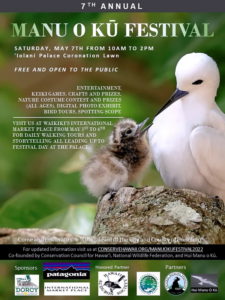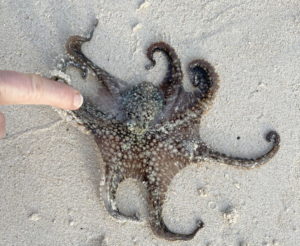
A feel-good moment: Craig and I returned this beached baby octopus to the ocean where it squirted a cloud of ink and disappeared. ©Craig Thomas
April 22, 2022
My daily routine of reading the Star-Advertiser, listening to HPR, and watching evening news has been like taking three depression pills, one after another. But when I’m feeling overdosed by bad news, I take my favorite antidotes: beach walks and bird tours.
These recent windy days have been especially rewarding, because the tradewinds blow in surprises from the sea, such as the baby octopus, above. For Craig and other sailors, the wind itself is the gift, delivering the means for exciting rides by filling kites, sails, and wing foils.
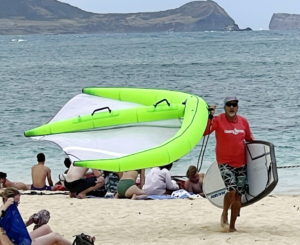
Craig after wing foiling at Lanikai Beach. In this sport, the sailor holds up an inflated sail while riding a surfboard with a hydrofoil attached below. © Susan Scott
My rewards are more sedate but no less exciting. Last week I found a baby fish washed up on the beach dead but in perfect condition. I didn’t know the fish but had clues as to its identity, and later found a nearly identical photo in my search. My best guess is that this is a lizardfish with an amazing number of names:
Three English: Blunt-nosed lizardfish, snake lizardfish, and painted grinner. (In Australia, lizardfish are called grinners .)
Two scientific : Trachinocephalus trachinus and Trachinocephalus myops.
One Hawaiian: wela’ā.
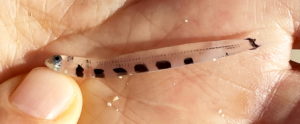
Possibly a wela’ā from Lanikai Beach. ©Susan Scott
Because lizardfish larvae of different species look similar, this may not be the species I found, but I’ll find out. I gave the delicate-looking youngster to HPU professor, Dr. David Hyrenbach, who studies seabird diets through DNA analysis of fish he finds in dead birds’ stomachs.
Of the world’s 50 or so lizardfish species, Hawaii hosts 15. These ambush predators lie motionless on the ocean floor, sometimes partly buried. Because lizardfish often stand on a pair of fins underneath and behind the fishes’ heads, such as in the photo below, their large toothy mouths are quite visible. This is where the Australian name grinner comes from.
The snake lizardfish ranges throughout the world’s tropical oceans, growing to 13 inches long. Hawaiians call Hawaiʻi’s other lizardfish ‘ulae, but named this one wele’ā because it looks so different from the others. Wele’ā has an upturned mouth, eyes high on its head and a body patterned with light blue lines.
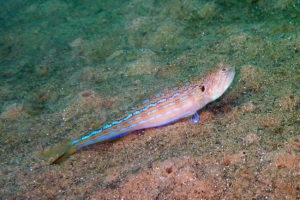
Snake lizardfish, or wele’ā, From Australia’s Museums of Victoria. fishesofaustralia.net.au/home/species/2783
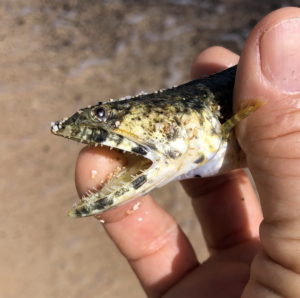
All lizardfish are ambush predators with sharp teeth lining the jaws and even the tongue. I found the fish dead on a North Shore beach, giving me the rare chance to look in its mouth and see its tongue teeth. ©Susan Scott
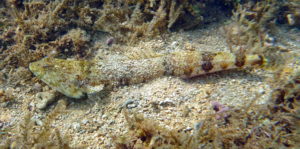
Lizardfish sometimes wiggle into the sand to cover themselves, all the better to ambush passing fish. This one, from a Waialua reef, is likely a Lobel’s lizardfish (Synodus lobeli), the most common lizardfish in Hawaii. It grows six inches long. ©Susan Scott
My other diversion from negative news lately is enjoying Honolulu’s official bird, the manu o kū (White Tern) by going on tours with those who monitor them. ( See www.whiteterns.org to help monitor White Terns.) As we followed White Tern volunteer, Melody Bentz, through UH Manoa, and oohed and aahed over an adorable chick, a parent arrived to feed it. A member of our group, Colin Morita, is a Punahou student and excellent photographer. Colin had a telephoto lens and showed me a close-up shot of the feeding on his camera’s monitor.
That picture (below) made my day: The meal consisted of three larval lizardfish, a subject I spent the previous day researching in my textbooks and on the Internet.
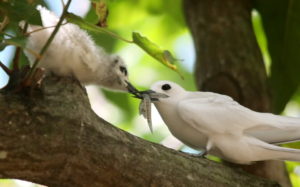
A manu o kū parent feeding its chick three tiny lizardfish in a tree at UH Manoa. ©Colin Morita
Beach walks and bird tours may not cure the ills of the world, but getting outdoors, noticing our island’s plants and animals, and making new friends, reminds me how connected we all are. (Colin is the son of a friend of a friend.) It also reminds me how lucky I am to live in Hawaiʻi.
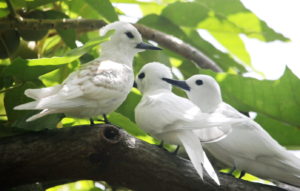
A manu o kū family (chick at left) at UH Manoa. ©Colin Morita
For the Hawaii Audubon Society’s tours and activities, go to www.hiaudubon.org/what we do
Join us Saturday at the 7th annual Manu o Kū Festival at ‘Iolani Palace:
